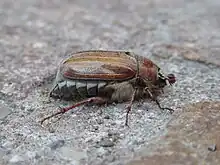| Melolontha hippocastani | |
|---|---|
 | |
| Scientific classification | |
| Domain: | Eukaryota |
| Kingdom: | Animalia |
| Phylum: | Arthropoda |
| Class: | Insecta |
| Order: | Coleoptera |
| Family: | Scarabaeidae |
| Genus: | Melolontha |
| Species: | M. hippocastani |
| Binomial name | |
| Melolontha hippocastani Fabricius, 1801 | |
Melolontha hippocastani is a species of scarab beetle native to Eurasia, with its range spanning from Europe to China. It is one of several species in the genus Melolontha known as cockchafers, alongside the common cockchafer (Melolontha melolontha) and Melolontha pectoralis.[1] The adults are around 20–29 mm in length.[2] It is distinguished from Melolontha melolontha by the shape of its pygidium, which is primarily black in colour.[1][2] It primarily dwells in forests, and as such is commonly known as the forest cockchafer. Females lay their eggs in soil, and the larvae feed on decaying organic matter and later small plant roots, including the roots of young trees like pines and firs. The larvae usually develop between 3 and 5 years. They emerge between late April and the end of June.[2] Like other cockchafers, they have been considered a serious pest of crops and trees.[1]
References
- 1 2 3 "Melolontha hippocastani Scarabaeidae". UK Beetles. Retrieved 2023-06-08.
- 1 2 3 "AgroAtlas - Pests - Melolontha hippocastani F. - Forest cockchafer". agroatlas.ru. Retrieved 2023-06-08.